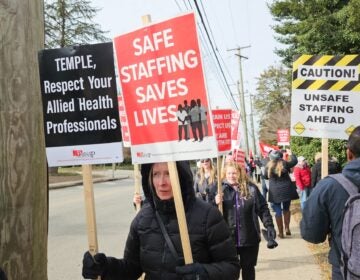Why mandated nurse-to-patient ratios have become one of the most controversial ideas in health care
The issue has divided nurses, confounded voters, and prompted a multimillion-dollar backlash by the hospital industry. Even research on the impact of ratio laws has been split
Listen 14:46
Nurses from National Nurses United gathered in Washington, D.C. on April 29 and 30 for their annual Lobby Day. (Image by Jaclyn Higgs, National Nurses United, 2019)
This story is from The Pulse, a weekly health and science podcast.
Subscribe on Apple Podcasts, Spotify or wherever you get your podcasts.
It was a busy night at the Chicago-area emergency room where Melissa Bertoletti worked. She was a triage nurse, which — even with her nearly 20 years of nursing experience — was a tough gig.
“Usually, you’re by yourself,” Bertoletti said. “As people are coming in, you’re kind of responsible for picking out the sickest patients and taking care of them first.”
Triage nurses are the first line of defense in an emergency room. It’s their job to assess and prioritize patients based on their condition. That means clearing the way for the most urgent cases.
“A lot of patients, they’ll come in with chest pain, abdominal pain, some patients come in suicidal,” Bertoletti said. “You have to make sure that they’re not having a heart attack at that very moment.”
It’s a fast-paced, high-pressure job that requires experience and a cool head — especially on nights like that one.
The ER was already crowded when a woman in her 40s came in with her husband, complaining of back and side pain. Bertoletti checked the woman’s vitals, as she was trained to do, and asked her to sit down.
“I remember the lobby that day — it was swamped with people,” Bertoletti said. “And we still had a lot coming in.”
After a couple hours, the woman returned to the desk with her husband. She told Bertoletti that she couldn’t wait any longer — the pain was too excruciating.
So Bertoletti picked up the phone to try to get the woman a bed. But as she was making the call, a new patient staggered in. He was gray, sweating, and clutching his chest.
“I knew he was in trouble,” she said. “He was for sure having a heart attack.”
Bertoletti called for a colleague to help her get the man an electrocardiogram and rushed him into the back.
When she returned, Bertoletti found that the woman complaining about severe pain had collapsed on the floor. A small crowd was gathered around her.
“My God, she passed out,” her ashen husband said.
Bertoletti called for help, and they started CPR right there in the lobby — but it wasn’t any use.
“You know, that woman died,” Bertoletti said. “She died waiting in the emergency room.”
Later, Bertoletti heard that the woman had an aortic dissection — a condition in which leaking blood forces apart the walls of the aorta, until it ruptures into the chest.
As she stood near the woman’s husband — his face a mask of shock and grief — Bertoletti couldn’t help thinking that this was more than just a terrible accident. It was something they could have, and should have, prevented.
“I really feel if there was another nurse up front with me, we could have reassessed her — maybe taken another set of vitals,” Bertoletti said. “We could have maybe saved her life.”
A few weeks after the incident, Bertoletti put in her notice.
“I felt defeated — I went to nursing school to help people and to save lives,” she said. “And I feel like I failed that woman.”
Bertoletti declined to name the hospital out of privacy concerns for the hospital and for the patients involved.
Seven years later, she works at a different hospital, but still thinks about that night regularly. It’s an experience that countless nurses across the country deal with on a daily basis — short staffing.
A 2018 survey — conducted by NursesTakeDC, a group that lobbies for stricter nurse-to-patient ratios, and analyzed by University of Illinois researchers along with the Illinois Economic Policy Institute — found that only 20% of nurses in the United States feel staffing levels are safe.
Increasingly, those concerns have been erupting into protest and political action. This year alone has seen more than a dozen nursing strikes across the U.S., including one that spanned four states and included thousands of nurses. Their No. 1 demand: better nurse-to-patient ratios.
It’s a common topic of contract negotiations. But in recent years, some nurses unions have been fighting for a more permanent solution: legislation that would limit the number of patients a nurse is legally allowed to care for.
Supporters argue that hospitals are shortchanging their nurse staffing to save a buck — in the process, burning out their nurses, and putting patients in danger. Opponents say ratio laws would exacerbate nursing shortages across the country, limiting access to care, and take important staffing decisions out of the hands of nurses.
The issue has divided nurses, confounded voters, and prompted a multimillion-dollar backlash by the hospital industry. Even research on the impact of ratio laws has been split.
What makes ratio laws so controversial? Could they really solve America’s problems with nurse staffing? And if not — what would work?
The argument against ratios
If anyone knows the argument against mandated ratios, it’s Danny Chun. He’s a spokesman for the Illinois Health and Hospital Association, one of the state’s leading advocacy groups for hospitals. Chun is unequivocal about the idea of legislated ratios.
“It’s a deeply flawed, inflexible, rigid approach to setting staffing levels that does not improve quality, safety or outcomes, but in fact would adversely affect patients,” he said.
The Illinois Health and Hospital Association has been outspoken against mandated ratios ever since the introduction earlier this year of the Safe Patient Limits Act. The bill, which found broad support among nursing groups, would set limits on the number of patients a nurse could be assigned, depending on hospital unit. Any facility that fails to comply could be subject to a fine of up to $25,000 for each day it is out of compliance.
Chun said the law might sound good in theory, but in practice could lead to lots of undesirable consequences — most of them predicated on a shortage of nurses, money, or both.
“It’s going to result in longer wait times for patients to get care in the emergency department and other units of the hospital,” Chun said. “Hospitals will be forced to turn away patients because they’ll have to go on emergency bypass and shut down some of their units because they don’t have enough nurses to meet the ratios.”
He added that an unexpected influx of patients, caused by anything ranging from a flu outbreak to a mass shooting, could mean there won’t be enough nurses on hand to meet the ratios.
The worst-case scenario, according to Chun, is that the law could force safety-net hospitals out of business.
“People don’t realize that in Illinois more than 40% of hospitals across the state, in every area of the state, are either losing money or barely surviving,” he said. “They’re financially fragile conditions. Imposing ratios would add a cost to the health care system of $2 billion a year. Many of our hospitals cannot absorb those costs. And a lot of those costs would be passed on to patients and families in the form of higher health care costs.”
But one of the biggest arguments against mandated ratios is that there’s simply no proof that they work to improve care for patients.
“The evidence is not conclusive that ratios improved quality, safety or outcomes,” Chun said.
The Illinois bill is currently stalled, but if recent history is any guide, it may never make it into law.
Chun’s arguments have been deployed before — and have won over the court of public opinion.
In 2018, Massachusetts voted on a similar bill, called the Patient Safety Act. It was posed as a ballot question, meaning voters, rather than state legislators, would vote it in or out. As a result, the proposal became a matter of fierce public debate, with both sides spending millions on campaign ads. In the end, the bill lost by a landslide, with 70% of voters rejecting it.
That doesn’t mean ratios legislation is doomed. The debate also played out years before in California, but with a different outcome. There, nurses’ unions succeeded in passing a ratios law in 1999. Today, it remains the only state in the country with mandated ratios.
As a result, California has become a rhetorical battleground over the question of whether or not ratios laws work, with researchers keeping a close eye on what the impact’s been. But not everyone agrees about what the research shows.
The argument for ratios
Doris Carroll first started to notice problems with nurse staffing around the early 1990s.
She graduated from nursing school in 1983, and went to work in a labor and delivery unit at a hospital in Chicago. In the beginning, she said, they’d have as many as 14 nurses assigned to a shift, which meant she was responsible for four or five patients.
“But when I left in the ’90s, we were down to five nurses,” Carroll said, which saddled her with double the number of patients.
“So very unsafe conditions, and that’s what drove me to leave — because I felt I couldn’t do what I had learned to do in nursing school and do it safely,” she said. “I remember going home crying because I felt like I had missed something.”
Over the next couple of decades, Carroll says, hospitals and health care became an increasingly corporate business.
“We became a line item in the budget that costs the hospital money,” Carroll said. “Who is the largest labor force in the hospital? It’s nurses. And if hospital administration can still make a profit and do it with a skeleton crew of nurses, they will do it anytime.”
Finally, in 2015, Carroll and a few colleagues decided to launch NursesTakeDC, a nonprofit group that advocates for safe nurse staffing.
“Nurses’ No. 1 duty to a patient is to be the patient advocate,” she said. “And when we say it’s unsafe at the bedside, it’s unsafe. We’re not making this up, and we have research to back us up.”
But nurses’ groups haven’t always succeeded in convincing the public. Carroll said that’s partially because of the money hospital groups have poured into the public debate. And there’s a complicating factor, she said.
“Actually, you’d be quite surprised who the other organization is that’s opposed to mandated ratios,” she said. “And that would be our very own professional organization, the American Nurses Association.”
Subscribe to The Pulse
Growth of the bedside nurses movement
The American Nurses Association’s reputation for opposing ratios goes back several decades, to the birth of California’s ratios law.
Gerard Brogan, who’s worked as a registered nurse in California since the late 1980s, recounts a similar shift in hospitals as the one described by Carroll.
“Nurses who worked in the ’80s and then in the ’90s and thereafter saw a sea change,” Brogan said. “It just became more corporate. Instead of focusing on quality patient care, they focused on the bottom line.”
Brogan says part of that shift involved hospitals laying off registered nurses, and replacing them with unlicensed assistant personnel. In response, he says, California nurses attempted to negotiate with the hospital industry as well as legislators to improve nurse staffing, all to no avail.
So the California Nurses Association — which was then a part of the American Nurses Association — began brainstorming solutions to the staffing problem.
“So we sat around and discussed this at great length, and decided that unless we got mandated numbers, the industry is always going to find a way around staffing properly,” Brogan said.
Brogan says the California Nurses Association turned to their national, mother group — the American Nurses Association — for support.
“You’re now the leading organization of nurses in the country, we’re asking you to do something about this,” Brogan said.
The California Nurses Association voted to split from the American Nurses Association in 1995, and pursue issues related to direct care nursing, meaning nurses who take care of patients.
“CNA pivoted to defending the work of the bedside nurses and defending patient care,” Brogan said. “And one of the strategies we used was to pursue nurse-to-patient ratios.”
They won that fight in 1999. Brogan says the law has transformed nursing in the state.
“Nurses are much happier in their work,” Brogan said. “They can now give the kind of care that they were trained to do, that their ethical push says they should do, as a registered nurse and as a patient advocate, and there’s less burnout.”
The campaign also gave rise to one of the biggest sponsors of ratio legislation in the country — National Nurses United, a “super union” formed in 2009, when the California Nurses Association merged with two other unions. National Nurses United is now the biggest nurses’ union in the country, and has gained a reputation for being progressive and politically active.
Today, Brogan serves as the director of nursing practice for both the California Nurses Association and National Nurses United, and he continues to be critical of the American Nurses Association.
“The problem with the ANA is, why do they align themselves with the industry rather than the bedside nurse?” he said. “And that’s the question literally not just on my lips, but on nearly every bedside nurse’s in this country’s lips.”
What the American Nurses Association says
Janet Haebler, a senior associate director for policy and state government affairs at the American Nurses Association, disputes the idea that the group opposes ratios.
“I don’t want to say we oppose ratios,” she said. “I want to say our approach is different.”
Haebler said the association has never come out in opposition to ratio legislation. But the group has publicly critiqued mandated ratios, including the Patient Safety Act, which its Massachusetts branch campaigned against, alongside the state’s largest hospital lobbying group.
She also echoed some of the hospital industry’s arguments against mandated ratios, including that they don’t improve patient outcomes.
Despite that, Haebler made a distinction: “It’s not that we’re against ratios,” she said. “We’re against legislating ratios.”
Putting ratios into law, Haebler said, robs nurses of the flexibility — and the independence — they need when it comes to staffing.
Instead, the group advocates a more fluid approach, one that’s able to adjust to changing conditions from day to day, patient to patient, unit to unit.
“The number of patients for whom a nurse nurse cares is not a true measure of the work that is involved,” Haebler said.
For instance, some patients require lots of time and care; others, much less. Likewise, nurses differ in their skill and experience levels. All of this and more, the American Nurses Association says, should be taken into account when determining staffing.
One way to do that is using acuity, which is a way of measuring and scoring the amount of care different patients need. For instance, more complicated or challenging patients would likely be deemed high acuity; less time-consuming patients would be low acuity. Ideally, that would be taken into account when assigning patients, so that no one ends up being overwhelmed with multiple high-acuity patients or caring for just a few low-acuity patients.
Hospitals use different tools to calculate acuity, ranging from custom-made to commercial software, but the common thread is that the approach is flexible. So instead of a fixed number of patients, nurses’ assignments shift from day to day.
The American Nurses Association also emphasizes that, unlike mandated ratios, its approach empowers nurses to make staffing decisions through a model called “shared governance,” in which committees of direct-care nurses weigh in on staffing decisions.
“We support flexibility,” Haebler said, “and the individual units within a facility staffing to what works for them.”
The pitfalls of flexibility
A version of the American Nurses Association’s approach already exists, in the form of Illinois’ Nurse Staffing by Patient Acuity Act, passed in 2007.
On its website, the Illinois Health and Hospital Association cites the law as sufficient for governing nurse staffing.
The law requires hospitals to form committees that are at least 50% nurses to make up staffing plans based on patient acuity.
But the aforementioned 2018 survey of Illinois nurses, conducted by NursesTakeDC, indicates that the law is being widely ignored.
Less than a third of respondents said their hospital had a staffing committee that they knew of. Of the hospitals that did, less than half worked the way they were supposed to — most either didn’t include enough nurses, or weren’t heeded at all.
Janet Haebler acknowledged that enforcement of the acuity law is a problem.
“All legislation needs to have some kind of enforcement provisions in it,” she said. “Regrettably, oftentimes when you’re negotiating to move something forward, that is something that you sacrifice.”
Enforcement and retaliation
As a result, the burden of enforcing staffing standards has fallen, in some cases, to nurses.
Among them is Julie Griffin, a longtime registered nurse in Florida who’s currently suing her former hospital.
“I’m claiming in the lawsuit that I was terminated for Medicare whistleblowing,” she said. “You know, I told them that it was against the law, and it was fraud. And I believe that I was targeted for this.”
To get Medicare money, hospitals have to follow certain rules. One of them is that in the intensive care unit, nurses can be assigned no more than two patients. But in the cardiovascular ICU where Griffin worked, she said it was common practice for nurses to handle three patients — sometimes five or six, when their colleagues were on break.
Griffin said the stress — along with the fear that she would accidentally hurt or kill a patient — took its toll.
“I was going home in tears,” she said. “I didn’t love my profession anymore.”
So Griffin started filing complaints — first to her supervisor, and then up the chain — but says she didn’t see anything change. It all came to a head one day when Griffin says her supervisor again asked her to take on a third patient, in violation of Medicare regulations. This time, Griffin refused.
“I didn’t want to be put in that situation where I could possibly lose my license,” she said. “We all knew it was wrong, but everybody was afraid to speak up about it.”
Documents supplied by Griffin show that she was disciplined for “Insubordination. Refusal to accept patient assignment.” Shortly after, she was fired.
Her former hospital, Westside Regional Medical Center in Florida, responded to questions about her termination with a statement:
“When there is an issue that could potentially affect patient care, we will take action and we are very comfortable with the decision to terminate this individual. We are proud of the quality care we provide and we will defend ourselves against these allegations through the legal process.”
According to the 2018 survey conducted by NursesTakeDC, 60 percent of nurses nationally said they fear retaliation for speaking up about staffing.
What the research says
Could mandated ratios solve the staffing problems nurses face?
A handful of researchers have begun pursuing an answer to that question by studying the impact of California’s ratios law.
Among them is Linda Aiken, a professor at the University of Pennsylvania School of Nursing and director of the Center for Health Outcomes and Policy Research, who’s spent decades researching the effects of nurse staffing on patients.
She begins by refuting one of the big claims against mandated ratios — that they don’t improve patient outcomes.
“No, that’s not true,” Aiken said. “I respectfully disagree. We’ve done a lot of research, and we have very good evidence that in jurisdictions, not only in the U.S. but in other countries that have adopted nurse-to-patient ratios, that staffing has improved and patient outcomes have improved as a result.”
Aiken has looked at patient outcomes in both California, which passed its ratio law in 1999, and Queensland, Australia, which passed one in 2015. She said the result for patients has been fewer complications, fewer infections, fewer injuries — and even lower mortality.
“Whether you can survive a cardiac arrest depends upon how fast someone sees that you’ve had one and can call help to come in,” she said. “And it’s all nurses. It’s all driven by nurses.”
What about the effects on health care costs or accessibility?
Aiken says the dire consequences that the hospital industry has warned of never materialized in either California or in Australia.
“No hospitals closed because they couldn’t get nurses, and no other part of the health care system was impacted either,” Aiken said. “No access-to-care problems, no emergency rooms closing, no consumer paid any more money as a result of this legislation that required hospitals to staff in an evidence-based way.”
Aiken said that’s in part because, despite warnings to the contrary, the U.S. has plenty of nurses.
“We have no nursing shortage in our country,” Aiken said. “There isn’t enough nursing care in a lot of hospitals, but that’s not because there’s a nursing shortage; it’s just because the hospitals are not employing enough nurses.”
At the bottom of all this, of course, is money.
The hospital industry says employing the extra nurses needed to meet ratios would be impossibly expensive.
But it turns out ratios might not be that bad for hospitals’ bottom lines. Aiken and other researchers have found that they could actually save money, because added nurses help prevent expensive patient complications to the tune of millions of dollars.
Aiken acknowledged that ratios are not the be-all and end-all of nurse staffing. She said acuity is also an important part of determining staffing.
“In setting these ratios, the purpose is not to say what the ideal is or what staffing should be,” she said. “It’s to set a minimum.”
In other words, what ratios offer is a starting point.
WHYY is your source for fact-based, in-depth journalism and information. As a nonprofit organization, we rely on financial support from readers like you. Please give today.







